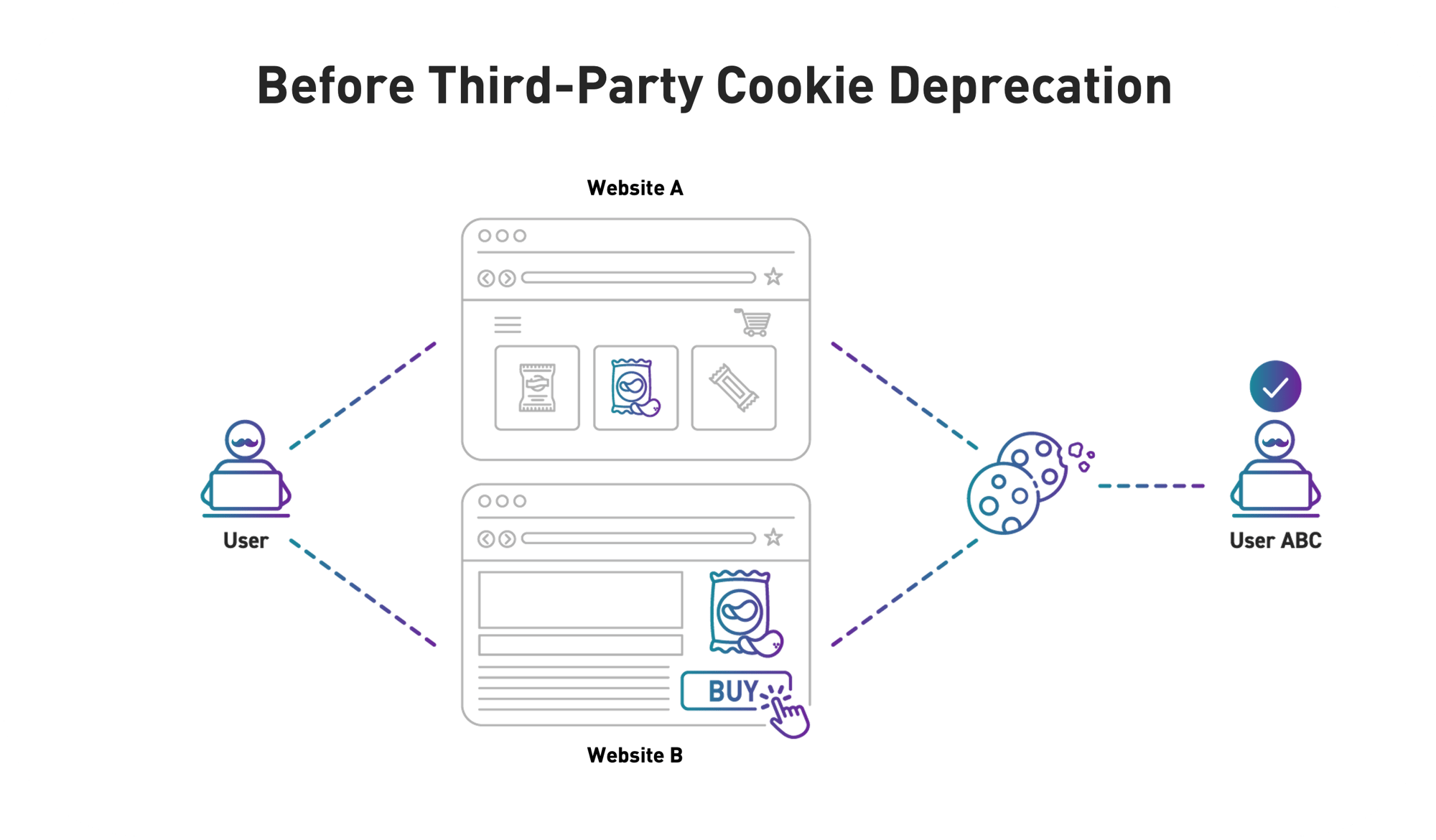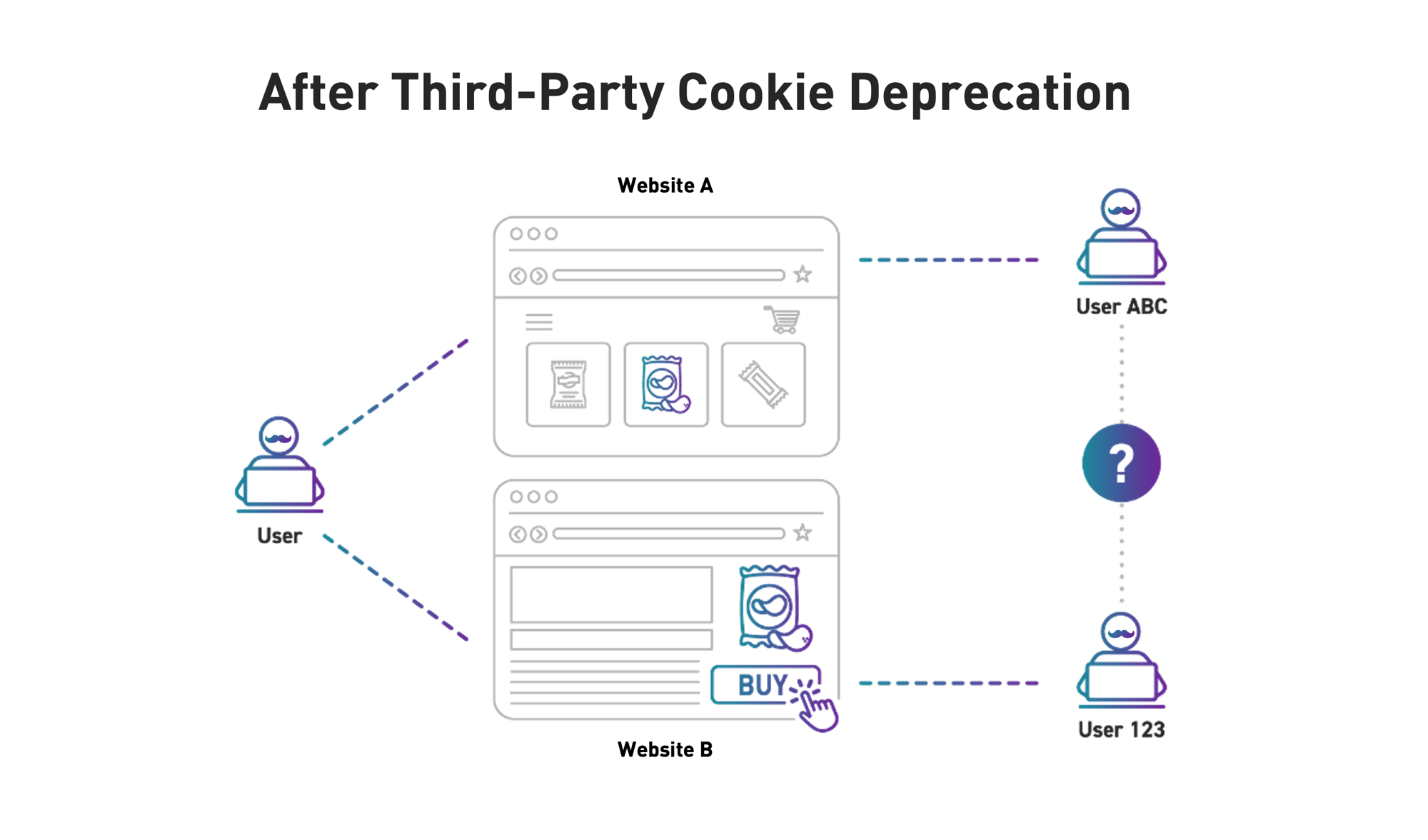NEW RESEARCH
Beyond Third-Party Cookies
How CPG Brands Can Reach Consumers at Scale and Drive Impact with Contextual Commerce
Chicory, in collaboration with Food Dive, conducted a survey of 150 marketing executives at various CPG brands. This research provides insights into how brands are responding to the deprecation of third-party cookies, and how contextual commerce will play a role in their advertising strategies moving forward.
Is Your CPG Brand Prepared to Move Beyond Third-Party Cookies?
Google began phasing out third-party cookies at the start of 2024, an action that will dramatically impact digital advertising strategies. 72% of CPG marketers are concerned about this shift, with budget concerns related to finding a replacement strategy (73%) and loss of scalability (70%) as their most significant pain points. To address these challenges, marketers are seeking and testing alternative advertising solutions.
While some are finding success already in new solutions, many are struggling with misinformation and confusion regarding which strategies will be most effective in the long term. As an intermediary in the grocery industry who works closely with CPGs, retailers, and publishers, Chicory is helping its network sift through this misinformation and develop scalable, future-proof advertising strategies.
What are third-party cookies?
Third-party cookies are a web-tracking tool used for digital advertising purposes. They have many uses including user targeting and cross-site tracking and measurement.


How are they used?
User Targeting
Most user targeting methods today are cookie-based, enabling advertisers to reach consumers based on their internet behaviors.
Behavioral targeting: Targeting based on a user’s web activities.
Retargeting: Targeting users who have previously visited your site or purchased your product.
Look-alike modeling: Targeting users who share certain characteristics of your ideal customers.
Audience Segments
Browsing behavior is used to create pools of third-party cookies of similar characteristics - i.e. sports enthusiast, gluten-free.
Brands can buy these audience segments in DSPs to target specific groups of people.
Cross-site Tracking and Measurement
Companies collect users’ browsing data across multiple websites to optimize targeting and measurement capabilities.
Frequency Capping: A feature that limits the number of times your display or video ads appear to a user.
Sequential Messaging: A feature that allows marketers to deliver ads in a particular order across a user’s devices to tell a clear story.
Multi-touch Attribution: A feature that allows marketers to understand the influence of each channel or advertisement on the user journey.
View-through conversions: A feature that allows marketers to attribute conversions to a particular ad during a pre-determined time window.
Analytics and Measurement: A component of a successful advertising campaign in which marketers use data generated by various sources to measure campaign performance and identify optimization opportunities.
What are the impacts or challenges of third-party cookie deprecation?
Budget & Resource Shifts
-
Third-party cookies allowed marketers to reach known users reliably and scalably. Because only 4% of open web traffic is authenticated, confidently reaching a user becomes much more difficult. Those that can guarantee reach, because they have authenticated users for example, will charge much higher CPMs. Gone are the days of cheap, reliable reach.
-
An analog to third-party cookie deprecation is Apple’s ATT. In the aftermath, we saw the economics of DTC businesses break. It became too expensive to reach the right users and CAC became too high. Many of those companies have gone out of business.
Open Web Issues
-
Data Efficacy Concerns - third-party cookies are the connection between a database of attributes and a user. Even if you have the most robust first-party data in the world, without third-party cookies you can’t reach that user on the open web. What good is data if you can’t target that consumer across the web?
-
Retargeting - One of the most basic and useful digital advertising tactics will no longer work.
-
Basic programmatic functionality - Even basic functionality like frequency capping will no longer work without third-party cookies.
Measurement
-
Consistent measurement will be difficult without third-party cookies to stitch together data across websites and walled gardens. If you can’t see that someone that saw an ad on website A and bought the product on website B, you don’t have a reliable measurement solution.
What alternative solutions or strategies are available to marketers?
There are many alternative strategies available to marketers. However, not all of these strategies are created equal. Marketers should plan to test several alternatives and incorporate multiple, synergistic tactics into their final advertising strategies. In doing so, they will minimize the impacts of future privacy regulations and achieve greater scale.
In this section, we outline the top alternatives that marketers are considering amid third-party cookie deprecation, detailing each of the strategies’ pros and cons. Acknowledging that this is an ongoing, evolving situation, the information in this list is by no means exhaustive and is expected to change over the next few months.
1. Deterministic First Party Data & Alternative IDs
These are consent-driven alternative IDs that aim to directly replace third-party cookies for ad targeting and other web use cases. Today, there is no single industry-accepted alternative ID, with many vendors competing to be the industry default. To leverage these IDs effectively, all organizations involved in an advertising exchange need to be integrated with the same identity graphs and those graphs need to be based on opted-in authenticated data.
Opportunities
-
Enables standard advertising capabilities used today with third-party cookies, such as user-level ad targeting, frequency capping, cross-device capabilities, and measurement.
-
Works well in closed environments (walled gardens), like social media platforms or retailer websites.
-
More stable than cookies: Cookies can deprecate, and users can clear them, while authenticated IDs are immune to these issues and thus more stable.
-
Retail media companies possess arguably the best first-party, opt-in hashed PII datasets in the advertising ecosystem.
-
Confidence and accuracy of this data are high.
Obstacles
-
As of today, alternative IDs still rely on cookies. Just because you’re using and testing an alternative ID does not mean you’re cookieless.
-
Relies on authenticated traffic from publishers which won’t scale well on the open web, where less than 5% of traffic is authenticated. There is limitation in the total reach of media campaigns and the potential to drive new and lapsed users.
-
Raises open legal and privacy-related questions: this strategy utilizes PII, and while based on consumer consent, it is unclear how PII usage will be impacted by future privacy regulations.
-
Reliance on disparate Identity Graphs: With 10+ viable universal IDs, all with different adoption rates, technical hurdles, and value props, there is a technical and business bandwidth limitation to testing these integrations.
-
Incremental fees for data where there used to be none since cookies were “free,” and now there are costs with things like identity graphs, data clean rooms, etc.
2. Probabilistic data
This refers to data represented through alternative IDs, not reliant on consent-driven first-party data but instead on assumptions and algorithms to probabilistically determine specific consumer characteristics. Vendors employ various methods such as analyzing traffic patterns, device fingerprinting, and artificial intelligence. Another term for this is "inferred IDs," as used by Index Exchange.
Opportunities
-
Scale: Can be utilized on both authenticated and unauthenticated traffic.
-
Already aligns with existing ad targeting methods, minimizing significant changes.
-
Offers flexibility: Most models allow for adjusting probabilities, enabling more accurate targeting at the expense of scale or broader audience reach.
Obstacles
-
Many probabilistic methods are reliant on soon-to-be-deprecated techniques. Browsers like Chrome are beginning to restrict available data for user fingerprinting, leading to decreased accuracy in probabilistic models.
-
Consent issues: Data matching across the entire buying ecosystem still requires consent consideration, posing significant privacy and legal challenges compared to deterministic data.
-
This type of data poses reliability concerns.
-
Reliance on newer and difficult-to-vet third parties.
-
Incurs incremental fees for data that used to be free with cookies, such as identity graphs and data clean rooms.
3. Privacy Sandbox
A series of APIs launched by Google intended to substitute the functionality of third-party cookies for digital advertising and general web use cases. The Privacy Sandbox initiative aims to create technologies balancing privacy protection and facilitating digital business growth. The proposals include measures to combat spam and fraud, deliver relevant content and ads, measure digital ads, strengthen cross-site boundaries, and limit covert tracking.
Opportunities
-
Provides alternative, privacy-friendly technologies for targeted advertising and enhances user privacy by reducing reliance on third-party cookies.
-
Offers transparency and control to users over their data usage for advertising, fostering trust and engagement.
-
Aligns with emerging privacy regulations like GDPR and CCPA by promoting privacy-preserving practices.
Obstacles
-
Contextual data offers a one-size-fits-all approach with limited customization, which results in a lack of user-level granularity.
-
Requires custom product and engineering work, currently compatible only with Chrome, leading to complexities in media planning and technical integration across browsers.
-
Potentially too restrictive in comparison to third party cookies.
-
Success depends on widespread industry adoption, which may face challenges due to diverse interests and stakeholders.
-
Transition away from third-party cookies may pose challenges for advertisers and publishers, particularly smaller ones, affecting targeting capabilities and ad revenue.
4. Contextual Targeting (for Programmatic)
Digital advertising based on the content of a specific webpage, typically keyword-based, without utilizing user-level or behavioral data in ad targeting. This form of contextual targeting does not take into account the type of content or how effective that content is at driving purchases.
Opportunities
-
Ability to reach new and lapsed users.
-
Turnkey solution: Most DSPs offer basic contextual offerings within their platforms.
-
Scalability: Unlocking access to off-site platforms, this targeting method is highly scalable.
-
Accessibility: There are already solutions available from reputable partners like Oracle, IAS, and DoubleVerify.
Obstacles
-
Concerns about vendors potentially infringing on copyrighted materials from publishers.
-
Limited customization and relevance to various verticals; basic contextual targeting relies solely on keywords and may not reflect true context or intent.
-
Lack of integration with unique ad formats or supply, leading to inefficient spending and a "spray and pray" approach with contextual targeting.
5. Contextual Commerce
Contextual commerce is a future-proof marketing strategy that transforms commerce-oriented content into a shopping moment—without relying on first or third-party data for targeting. Popular examples of contextual commerce in the grocery space include in-recipe advertising, complementary product recommendations, and commerce-enabled links within food content. Each of these reaches consumers with hyper-relevant messaging during high-intent moments of the grocery shopping journey.
Opportunities
-
Scalability: Contextual commerce ads reach existing and new shoppers in high-intent, off-site environments, like recipe sites.
-
Proven ROAS: Chicory's contextual campaigns drive incremental sales (average 2.5X iROAS, with a high of 5x).
-
Ability to reach new and lapsed users: Almost half of all sales in Chicory’s network come from new and lapsed shoppers.
-
Increased brand affinity and awareness: 79% of consumers say contextual, in-recipe ads positively impact their perception of the advertised brand.
-
Integrated directly with the publisher, providing benefits such as direct access to supply, innovativenovel ad formats, experiences that can only work with that direct connection, and a privacy/copyright-friendly framework.
Obstacles
-
Not at the user level: Contextual commerce targets based on context, not users, allowing ads to reach certain audiences (e.g., vegetarians, gluten-free shoppers, etc.), but not specific people within those audiences.
-
Limited by vertical: Contextual commerce takes both the relevance of the content and the shoppers’ mindset into account, often limiting its focus to a particular vertical (e.g., recipes for CPGs).
-
Not programmatic or turnkey (for now): With its focus on hyper-relevant content and personalization, there is some upfront information required for a contextual commerce provider to best serve its clients and their unique needs.




